Adjusting entries are accounting journal entries that convert a company’s accounting records to theaccrual basis of accounting.An adjusting journal entry is typically made just prior to issuing a company’sfinancial statements.
The Reasons Why the Life of a Business is divided into Accounting Period
Explain why the life of a business is divided into accounting period
An
accounting adjustment is a business transaction that has not yet been
included in the accounting records of a business as of a specific date.
Most transactions are eventually recorded through the recordation of
(for example) a supplier invoice, a customer billing, or the receipt of
cash. Such transactions are usually entered in a module of the
accounting software that is specifically designed for it, and which
generates an accounting entry on behalf of the user.
accounting adjustment is a business transaction that has not yet been
included in the accounting records of a business as of a specific date.
Most transactions are eventually recorded through the recordation of
(for example) a supplier invoice, a customer billing, or the receipt of
cash. Such transactions are usually entered in a module of the
accounting software that is specifically designed for it, and which
generates an accounting entry on behalf of the user.
However,
if such transactions have not yet been recorded as of the end of an
accounting period, or if the entry incorrectly states the impact of the
transaction, the accounting staff makes accounting adjustments in the
form of adjusting entries. These adjustments are designed to bring the
company’s reported financial results into compliance with the dictates
of the relevant accounting framework, such as Generally Accepted
Accounting Principles or International Financial Reporting Standards.
The adjustments are primarily used under the accrual basis of
accounting. Examples of such accounting adjustments are:
if such transactions have not yet been recorded as of the end of an
accounting period, or if the entry incorrectly states the impact of the
transaction, the accounting staff makes accounting adjustments in the
form of adjusting entries. These adjustments are designed to bring the
company’s reported financial results into compliance with the dictates
of the relevant accounting framework, such as Generally Accepted
Accounting Principles or International Financial Reporting Standards.
The adjustments are primarily used under the accrual basis of
accounting. Examples of such accounting adjustments are:
- Altering the amount in a reserve account, such as the allowance for doubtful accounts or the inventory obsolescence reserve.
- Recognizing revenue that has not yet been billed.
- Deferring the recognition of revenue that has been billed but has not yet been earned.
- Recognizing expenses for supplier invoices that have not yet been received.
- Deferring
the recognition of expenses that have been billed to the company, but
for which the company has not yet expended the asset. - Recognizing prepaid expenses as expenses.
The Reasons Why the Accounts must be Adjusted at the End of Each Accounting Period
State why the accounts must be adjusted at the end of each accounting period
Some
of these accounting adjustments are intended to be reversing entries –
that is, they are to be reversed as of the beginning of the next
accounting period. In particular, accrued revenue and expenses should be
reversed. Otherwise, inattention by the accounting staff may leave
these adjustments on the books in perpetuity, which may cause future
financial statements to be incorrect. Reversing entries can be set to
automatically reverse in a future period, thereby eliminating this risk.
of these accounting adjustments are intended to be reversing entries –
that is, they are to be reversed as of the beginning of the next
accounting period. In particular, accrued revenue and expenses should be
reversed. Otherwise, inattention by the accounting staff may leave
these adjustments on the books in perpetuity, which may cause future
financial statements to be incorrect. Reversing entries can be set to
automatically reverse in a future period, thereby eliminating this risk.
Accounting
adjustments can also apply to prior periods when the company has
adopted a change in accounting principle. When there is such a change,
it is carried back through earlier accounting periods, so that the
financial results for multiple periods will be comparable
adjustments can also apply to prior periods when the company has
adopted a change in accounting principle. When there is such a change,
it is carried back through earlier accounting periods, so that the
financial results for multiple periods will be comparable
How Adjusting Entries are Related to the Concept of Accrual Accounting and Matching Principle
Explain how adjusting entries are related to the concept of accrual accounting and matching principle
An
adjusting entry to accrue expenses is necessary when there are
unrecorded expenses and liabilities that apply to a given accounting
period. These expenses may include wages for work performed in the
current accounting period but not paid until the following accounting
period and also the accumulation of interest on notes payable and other
debts.
adjusting entry to accrue expenses is necessary when there are
unrecorded expenses and liabilities that apply to a given accounting
period. These expenses may include wages for work performed in the
current accounting period but not paid until the following accounting
period and also the accumulation of interest on notes payable and other
debts.
Suppose
a company owes its employees $2,000 in unpaid wages at the end of an
accounting period. The company makes an adjusting entry to accrue the
expense by increasing (debiting) wages expense for $2,000 and by
increasing (crediting) wages payable for $2,000.
a company owes its employees $2,000 in unpaid wages at the end of an
accounting period. The company makes an adjusting entry to accrue the
expense by increasing (debiting) wages expense for $2,000 and by
increasing (crediting) wages payable for $2,000.
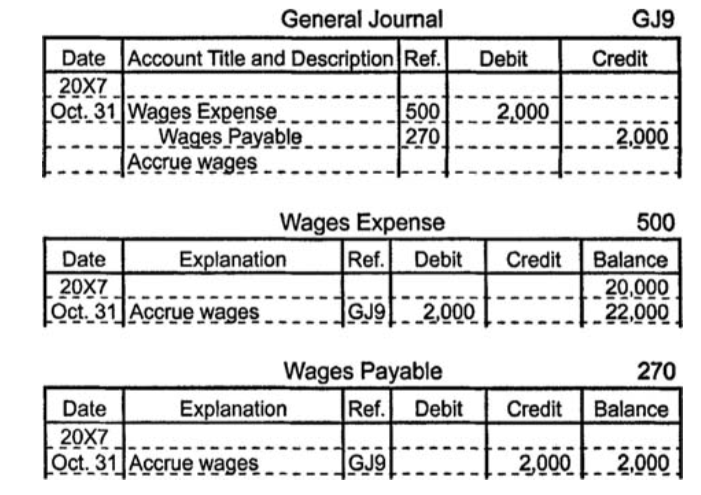
If
a long-term note payable of $10,000 carries an annual interest rate of
12%, then $1,200 in interest expense accrues each year. At the close of
each month, therefore, the company makes an adjusting entry to increase
(debit) interest expense for $100 and to increase (credit) interest
payable for $100.
a long-term note payable of $10,000 carries an annual interest rate of
12%, then $1,200 in interest expense accrues each year. At the close of
each month, therefore, the company makes an adjusting entry to increase
(debit) interest expense for $100 and to increase (credit) interest
payable for $100.
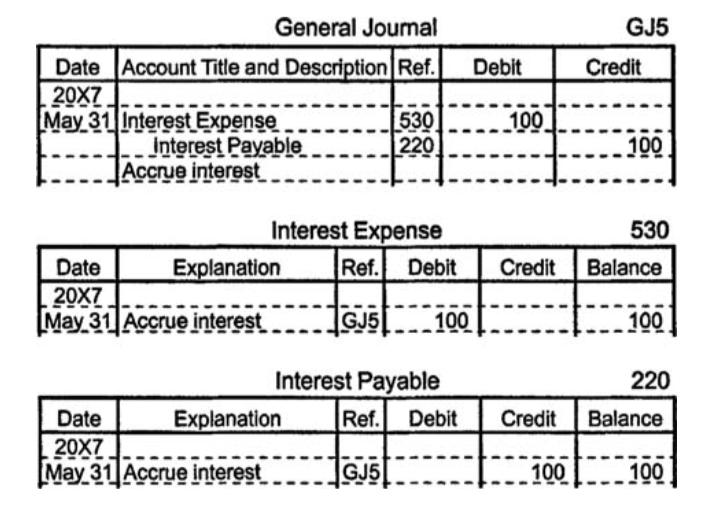
Accounting
records that do not include adjusting entries for accrued expenses
understate total liabilities and total expenses and overstate net
income.
records that do not include adjusting entries for accrued expenses
understate total liabilities and total expenses and overstate net
income.
The Four Basic Adjusting Entries
Describe the four basic adjusting retries
Basic types of adjusting journal entries:
- Accrued revenues(also
called accrued assets) are revenues already earned but not yet paid by
the customer or posted to the general ledger. An example of accrued
revenue would be for a custom ordered machine that has been shipped FOB
shipping point on the day the accounts receivable module is closed and
the approval to bill the customer has not been received by the billing
clerk. An adjusting entry would be recorded to recognize the revenue in
the correct period. This entry will reverse when the customer is
appropriately invoiced. Accrued Revenue 14,00; Revenue 14,000 - Unearned revenues(or
deferred revenues) are revenues received in cash and recorded as
liabilities prior to being earned. Unearned revenue is a liability to
the entity until the revenue is earned. An example of unearned revenue
would be if the customer paid a deposit for a custom ordered machine
that has not been delivered, the deposit would be recorded as unearned
revenue. This type of adjusting entry will be adjusted by another entry.
Revenue 14,000; Deferred Revenue 14,000 - Accrued expenses(also
called accrued liabilities) are expenses already incurred but not yet
paid or recorded. Examples of these types of adjusting entries could be
for payroll that has been earned by employees on the last day of the
period but not paid until the next payroll date. These types of entries
generally reverse the next month. Salaries Expense 89,000; Salaries
Payable 89,000 - Prepaid expenses(or deferred
expenses) are expenses paid in cash and recorded as assets prior to
being used. The most common form of an adjusting entry for prepaid
expense would be for the used portion of an insurance premium. These
types of adjusting entries are usually permanent. Insurance Expense
1,000; Prepaid Insurance 1,000 - Other adjusting entries includedepreciationof fixed assets, allowancesfor bad debts, and inventory adjustments. Bad Debt Expense 50; Allowance for Bad debt 50 (Adjusting EN, 2010)
At
the end of each closing period, usually monthly, a thorough analysis of
the trial balance is preformed. This analysis includes performance
budget to actual and month to month to ensure all of the accounts are
correctly stated. When an adjusting entry is identified, a journal entry
input form is prepared. This form should be supported with source
documents that justify the entry and reviewed and approved by the
appropriate level of accounting management. Once the approval has been
obtained, the journal entry is keyed into the general ledger system as
either a standard or self reversing journal entry. The journal entry is
then posted to the general ledger.
the end of each closing period, usually monthly, a thorough analysis of
the trial balance is preformed. This analysis includes performance
budget to actual and month to month to ensure all of the accounts are
correctly stated. When an adjusting entry is identified, a journal entry
input form is prepared. This form should be supported with source
documents that justify the entry and reviewed and approved by the
appropriate level of accounting management. Once the approval has been
obtained, the journal entry is keyed into the general ledger system as
either a standard or self reversing journal entry. The journal entry is
then posted to the general ledger.
Preparation of Adjusting Entries for Prepaid Expenses, Unearned Revenue, Accrued Revenues and Depreciation
Prepare adjusting entries for prepaid expenses, unearned revenue, accrued Revenues and depreciation
Prepaid
expenses are assets that become expenses as they expire or get used up.
For example, office supplies are considered an asset until they are
used in the course of doing business, at which time they become an
expense. At the end of each accounting period, adjusting entries are
necessary to recognize the portion of prepaid expenses that have become
actual expenses through use or the passage of time.
expenses are assets that become expenses as they expire or get used up.
For example, office supplies are considered an asset until they are
used in the course of doing business, at which time they become an
expense. At the end of each accounting period, adjusting entries are
necessary to recognize the portion of prepaid expenses that have become
actual expenses through use or the passage of time.
Consider
the previous example from the point of view of the customer who pays
$1,800 for six months of insurance coverage. Initially, she records the
transaction by increasing one asset account (prepaid insurance) with a
debit and by decreasing another asset account (cash) with a credit.
After one month, she makes an adjusting entry to increase (debit)
insurance expense for $300 and to decrease (credit) prepaid insurance
for $300.
the previous example from the point of view of the customer who pays
$1,800 for six months of insurance coverage. Initially, she records the
transaction by increasing one asset account (prepaid insurance) with a
debit and by decreasing another asset account (cash) with a credit.
After one month, she makes an adjusting entry to increase (debit)
insurance expense for $300 and to decrease (credit) prepaid insurance
for $300.
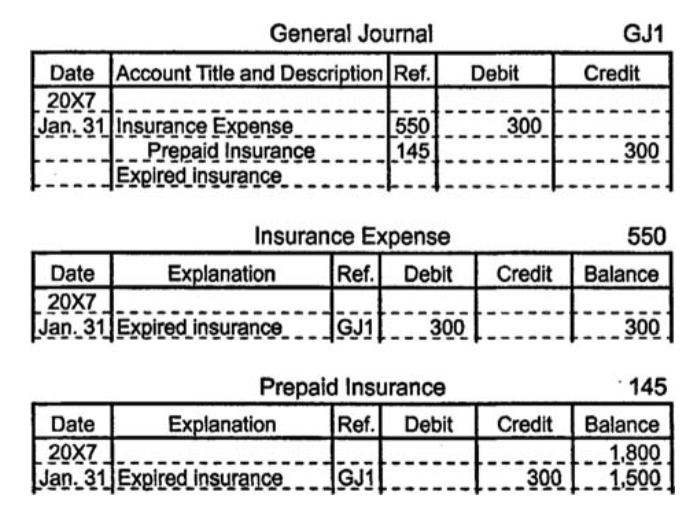
Prepaid
expenses in one company’s accounting records are often—but not always—
unearned revenues in another company’s accounting records. Office
supplies provide an example of a prepaid expense that does not appear on
another company’s books as unearned revenue.
expenses in one company’s accounting records are often—but not always—
unearned revenues in another company’s accounting records. Office
supplies provide an example of a prepaid expense that does not appear on
another company’s books as unearned revenue.
Accounting
records that do not include adjusting entries to show the expiration or
consumption of prepaid expenses overstate assets and net income and
understate expenses.
records that do not include adjusting entries to show the expiration or
consumption of prepaid expenses overstate assets and net income and
understate expenses.
Preparation of Entries to Dispose of Accrued Revenue and Expense Items in Three New Accounting Period
Prepare entries to dispose of accrued revenue and expense items in thee new accounting period
Accrued
income is an amount earned but not actually received during the
accounting period or till the date of preparation of Final Accounts for
the period concerned. Such an income receivable is also called income
earned but not received or income accrued or income due and outstanding.
income is an amount earned but not actually received during the
accounting period or till the date of preparation of Final Accounts for
the period concerned. Such an income receivable is also called income
earned but not received or income accrued or income due and outstanding.
For
instance, interest on investments, rent from sub-letting, commission on
sales etc., earned by the business during a particular accounting
period but might not have been received so far. Thus such outstanding
income needs adjustment when Final Accounts are prepared. For instance,
commission has been earned but not received Rs 100.
instance, interest on investments, rent from sub-letting, commission on
sales etc., earned by the business during a particular accounting
period but might not have been received so far. Thus such outstanding
income needs adjustment when Final Accounts are prepared. For instance,
commission has been earned but not received Rs 100.
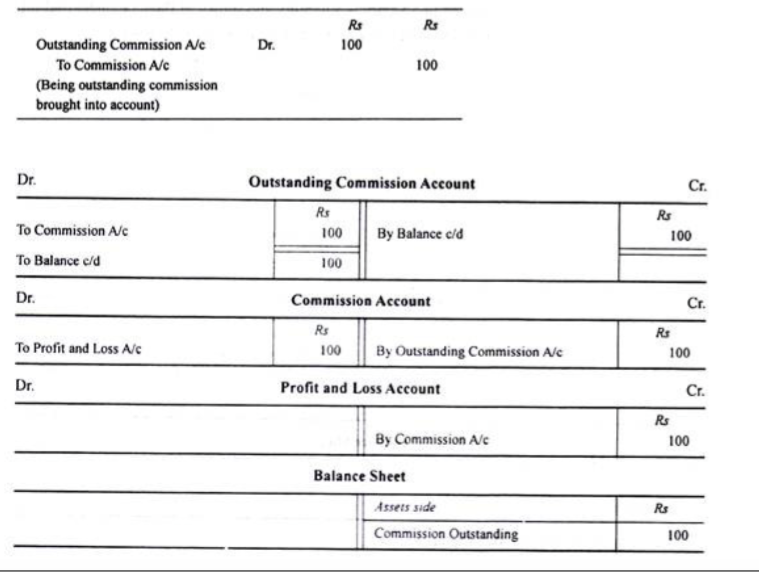
The double effect of accrued income is:
- It is credited to the Profit & Loss Account
- It is shown in the asset side of the Balance Sheet. Income Received in Advance: Adjustment Entries in Final Accounts!
Income
received during a particular trading period for the work to be done in
future is termed as unearned income. When income is received in advance,
for the work not done yet, the trader is liable that is such income
though received is not the income for the current trading period, but
services will be rendered in the next year.
received during a particular trading period for the work to be done in
future is termed as unearned income. When income is received in advance,
for the work not done yet, the trader is liable that is such income
though received is not the income for the current trading period, but
services will be rendered in the next year.
The
unearned income is deducted from the concerned income, in the credit
side of Profit and Loss Account and also shown in the liability side of
the Balance Sheet. For insurance, a trade received rent @ Rs 200 per
month for a full year ending on 31st March 2005 but his Final Accounts
are prepared for the year ending on 31st December 2004.
unearned income is deducted from the concerned income, in the credit
side of Profit and Loss Account and also shown in the liability side of
the Balance Sheet. For insurance, a trade received rent @ Rs 200 per
month for a full year ending on 31st March 2005 but his Final Accounts
are prepared for the year ending on 31st December 2004.
Then, the entries are:
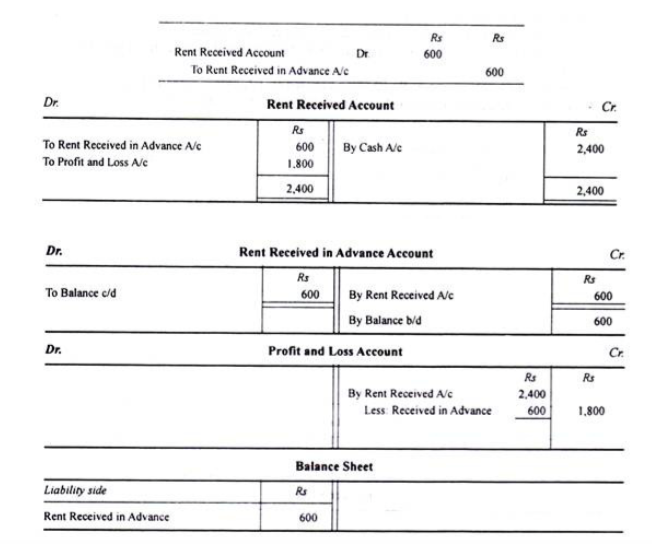
The double effect in the Final Account is:
- The unearned income is deducted from Rent Received Account.
- The deducted amount is shown in the liability side of the Balance Sheet
Example 1
Ashok
and Tanaji are Partners sharing Profit and Losses in the ratio 2:3
respectively. Their Trial Balance as on 31st March, 2007 is given below.
You are required to prepare Trading and Profit and Loss Account for the
year ended 31stMarch, 2007 and Balance Sheet as on that date after
taking into account given adjustments.
and Tanaji are Partners sharing Profit and Losses in the ratio 2:3
respectively. Their Trial Balance as on 31st March, 2007 is given below.
You are required to prepare Trading and Profit and Loss Account for the
year ended 31stMarch, 2007 and Balance Sheet as on that date after
taking into account given adjustments.
| Particulars | Amt. (Rs.) | Particulars | Amt. (Rs.) |
| PurchasesPatents RightBuilding | 98,0004,0001,00,000 | Capital: Ashok Tanaji | 30,00040,000 |
| Stock (1.04.2006) | 15,000 | Provident Fund | 7,000 |
| Printing and Stationery | 1,750 | Creditors | 45,000 |
| Sundry Debtors Wages and Salaries | 35,00011,000 | 10% Bank Loan taken on 1st April 2006 | 12,000 |
| Audit Fees | 700 | Sales | 1,58,000 |
| Sundry Expenses | 3,500 | Reserve for Doubtful Debts | 250 |
| Furniture | 8,000 | Purchase Returns | 3,500 |
| Investment | 10,000 | ||
| Cash | 4,000 | ||
| Provident Fund Contribution | 800 | ||
| Carriage Inwards | 1,300 | ||
| Travelling Expenses | 2,700 | ||
| 2,95,750 | 2,95,750 |
Adjustments:
Activity 1
- Closing stock is valued at the cost of Rs. 15,000 while its market price is Rs.18,000.
- On 31st March, 2007 the stock of stationery was Rs. 500.
- Provide reserve for bad and doubtful debts at 5% on debtors.
- Depreciate building at 5% and patent rights at 10%. p.a.
- Interest on capitals is to be provided at 5%
Difference between the Cash and Accrual Basis of Accounting
Explain the difference between the cash and accrual basis of accounting
Under the cash basis of accounting
- Revenuesare reported on theincome statementin the period in which the cash is received from customers.
- Expensesare reported on the income statement when the cash is paid out.
Under theaccrual basis of accounting.
- Revenues are reported on the income statement when they areearned—which often occurs before the cash is received from the customers.
- Expenses
are reported on the income statement in the period when they occur or
when they expire—which is often in a period different from when the
payment is made.
The
accrual basis of accounting provides a better picture of a company’s
profits during anaccounting period. The reason is that the income
statement prepared under the accrual basis will report all of the
revenues actuallyearnedduring the period and all of the expenses incurred in order to earn the revenues.
accrual basis of accounting provides a better picture of a company’s
profits during anaccounting period. The reason is that the income
statement prepared under the accrual basis will report all of the
revenues actuallyearnedduring the period and all of the expenses incurred in order to earn the revenues.
The
accrual basis of accounting also provides a better picture of a
company’s financial position at a moment or point in time. The reason is
that all assets that were earned are reported and allliabilitiesthat
were incurred will be reported.
accrual basis of accounting also provides a better picture of a
company’s financial position at a moment or point in time. The reason is
that all assets that were earned are reported and allliabilitiesthat
were incurred will be reported.
The accrual basis of accounting is required because of the matching principle.
Importance of Comparability in the Financial Statements of a Business, Period after Period
Explain the importance of comparability in the financial statements of a business, period after period
Comparability
is one of the key qualities which accounting information must possess.
Accounting information is comparable when accounting standards and
policies are applied consistently from one period to another and from
one region to another. The characteristic of comparability offinancial
statementsis important because it allows us to compare a set of
financial statements with those of prior periods and those of other
companies.
is one of the key qualities which accounting information must possess.
Accounting information is comparable when accounting standards and
policies are applied consistently from one period to another and from
one region to another. The characteristic of comparability offinancial
statementsis important because it allows us to compare a set of
financial statements with those of prior periods and those of other
companies.
For example
- We
can compare 20X2 financial statements of ExxonMobil with its 20X1
financial statements to know whether performance and position improved
or deteriorated. - We can compare the ExxonMobil financial
statements with that of BP if both are prepared in accordance with same
set of accounting standards, such as IFRS or US GAAP, etc. - When
preparing 20X3 financial statements we are required to present with each
of the 20X3 figure the corresponding 20X2 figures. This is done to add
the characteristic of comparability to the financial statements.
Accounting
standards are intended to outline the best accounting treatment so that
companies follow them and hence accounting information
isunderstandable,relevant and reliableand comparable.Consistencymeans
that the accounting policies should be changed only when there are valid
grounds for such a change.
standards are intended to outline the best accounting treatment so that
companies follow them and hence accounting information
isunderstandable,relevant and reliableand comparable.Consistencymeans
that the accounting policies should be changed only when there are valid
grounds for such a change.
How the Realization Principle and the Matching Principle Attribute to Comparability
Explain how the realization principle and the matching principle attribute to comparability
Realization
concept in accounting, also known as revenue recognition principle,
refers to the application of accruals concept towards the recognition of
revenue (income).Under this principle, revenue is recognized by the
seller when it is earned irrespective of whether cash from the
transaction has been received or not.
concept in accounting, also known as revenue recognition principle,
refers to the application of accruals concept towards the recognition of
revenue (income).Under this principle, revenue is recognized by the
seller when it is earned irrespective of whether cash from the
transaction has been received or not.
In
case of sale of goods, revenue must be recognized when the seller
transfers the risks and rewards associated with the ownership of the
goods to the buyer. This is generally deemed to occur when the goods are
actually transferred to the buyer. Where goods are sold on credit
terms, revenue is recognized along with a corresponding receivable which
is subsequently settled upon the receipt of the due amount from the
customer.
case of sale of goods, revenue must be recognized when the seller
transfers the risks and rewards associated with the ownership of the
goods to the buyer. This is generally deemed to occur when the goods are
actually transferred to the buyer. Where goods are sold on credit
terms, revenue is recognized along with a corresponding receivable which
is subsequently settled upon the receipt of the due amount from the
customer.
Example 2
Motors
PLC is a car dealer. It receives orders from customers in advance
against 20% down payment. Motors PLC delivers the cars to the respective
customers within 30 days upon which it receives the remaining 80% of
the list price
PLC is a car dealer. It receives orders from customers in advance
against 20% down payment. Motors PLC delivers the cars to the respective
customers within 30 days upon which it receives the remaining 80% of
the list price
In
accordance with the revenue realization principle, Motors PLC must not
recognize any revenue until the cars are delivered to the respective
customers as that is the point when the risks and rewards incidental to
the ownership of the cars are transferred to the buyers.
accordance with the revenue realization principle, Motors PLC must not
recognize any revenue until the cars are delivered to the respective
customers as that is the point when the risks and rewards incidental to
the ownership of the cars are transferred to the buyers.
Application
of the realization principle ensures that the reported performance of
an entity, as evidenced from the income statement, reflects the true
extent of revenue earned during a period rather than the cash inflows
generated during a period which can otherwise be gauged from the cash
flow statement. Recognition of revenue on cash basis may not present a
consistent basis for evaluating the performance of a company over
several accounting periods due to the potential volatility in cash
flows.
of the realization principle ensures that the reported performance of
an entity, as evidenced from the income statement, reflects the true
extent of revenue earned during a period rather than the cash inflows
generated during a period which can otherwise be gauged from the cash
flow statement. Recognition of revenue on cash basis may not present a
consistent basis for evaluating the performance of a company over
several accounting periods due to the potential volatility in cash
flows.
Matching Principle
requires that expenses incurred by an organization must be charged to
the income statement in the accounting period in which the revenue, to
which those expenses relate, is earned.
requires that expenses incurred by an organization must be charged to
the income statement in the accounting period in which the revenue, to
which those expenses relate, is earned.
Prior
to the application of the matching principle, expenses were charged to
the income statement in the accounting period in which they were paid
irrespective of whether they relate to the revenue earned during that
period. This resulted in non recognition of expenses incurred but not
paid for during an accounting period (i.e. accrued expenses) and the
charge to income statement of expenses paid in respect of future periods
(i.e. prepaid expenses). Application of matching principle results in
the deferral of prepaid expenses in order to match them with the revenue
earned in future periods. Similarly, accrued expenses are charged in
the income statement in which they are incurred to match them with the
current period’s revenue.
to the application of the matching principle, expenses were charged to
the income statement in the accounting period in which they were paid
irrespective of whether they relate to the revenue earned during that
period. This resulted in non recognition of expenses incurred but not
paid for during an accounting period (i.e. accrued expenses) and the
charge to income statement of expenses paid in respect of future periods
(i.e. prepaid expenses). Application of matching principle results in
the deferral of prepaid expenses in order to match them with the revenue
earned in future periods. Similarly, accrued expenses are charged in
the income statement in which they are incurred to match them with the
current period’s revenue.
A
major development from the application of matching principle is the use
of depreciation in the accounting for non-current assets. Depreciation
results in a systematic charge of the cost of a fixed asset to the
income statement over several accounting periods spanning the asset’s
useful life during which it is expected to generate economic benefits
for the entity. Depreciation ensures that the cost of fixed assets is
not charged to the profit & loss at once but is ‘matched’ against
economic benefits (revenue or cost savings) earned from the asset’s use
over several accounting periods.
major development from the application of matching principle is the use
of depreciation in the accounting for non-current assets. Depreciation
results in a systematic charge of the cost of a fixed asset to the
income statement over several accounting periods spanning the asset’s
useful life during which it is expected to generate economic benefits
for the entity. Depreciation ensures that the cost of fixed assets is
not charged to the profit & loss at once but is ‘matched’ against
economic benefits (revenue or cost savings) earned from the asset’s use
over several accounting periods.
Matching
principle therefore results in the presentation of a more balanced and
consistent view of the financial performance of an organization than
would result from the use of cash basis of accounting.
principle therefore results in the presentation of a more balanced and
consistent view of the financial performance of an organization than
would result from the use of cash basis of accounting.
























































Im obliged for the blog post. Really looking forward to read more. Really Cool.
I used to be able to find good information from your content.
I loved your article post. Keep writing.
Everything is very open with a very clear description of the issues. It was truly informative. Your website is useful. Thank you for sharing.